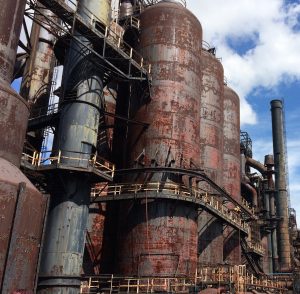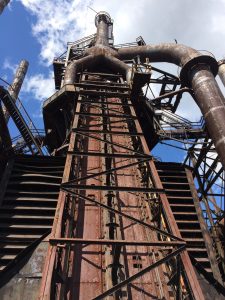Steel Stacks and Readings
In the piece “Ships Stranded in the Forest,” Gordillo tells the story of the ruins of steamboats left in the forest near a deserted, rural town called Rivadiva. The ships’ ruins correspond directly with the dramatic decline of the town, and now that no one is alive who saw the ships in their prime, they’ve taken on a mythic quality that Gordillo describes such: “the image of a ship stranded in the forest was an immobile, poignant expression of abandonment and decline.” The ruins of the steam boats reminded me of the Bethlehem steel stacks. The stacks too are immobile, rusting ruins reminding us of days gone by when they were useful. Unlike the steamboats, though, the steel stacks have taken on a new purpose of education and remembrance, and have become a cultural center. They remain relevant in modern life despite the fact that they are no longer used for their intended purpose.

In his “Theses on the Philosophy of History,” Benjamin uses markers of decay to criticize progress, portraying progress as a storm that creates “one single catastrophe which keeps piling wreckage upon wreckage” and leaves “a pile of debris” on its wake. This is true when one thinks about the steamboats left behind in Rivadiva, or the steel stacks in Bethlehem, but the transformation of the steel stacks into something useful and relevant–extending it’s life beyond what was originally predicted–proves that progress is not only negative.
This article attempts to explain the social and historical relevance of destroyed things by using the example of Rivadiva– a very poor, “backwards,” and rural town. Integral to the history and current situation of the town is the silent monument of a steamboat in the woods, left behind when the river disappeared. Gordillo states that “the collective memory of the steamships that had navigated the river and the dramatic disruption created by the river’s disappearance were central to local subjectivities.” The ships served as emblems of wealth before the river dried up, similar to how the steel stacks in Bethlehem symbolize a lost time of prosperity and industry. When they were closed, Bethlehem lost one of it’s defining features, and has attempted to recapture that definition by transforming the stacks into a cultural center. Although this is positive for many reasons, the tour guide I spoke to emphasized the fact that this was a really difficult place to work for many reasons–the work was extremely physically demanding, it was dangerous, loud, hot, and a hard life for the workers. Today, having concerts and shops and everything there while ignoring the history of the people behind the steel stacks is not good. That’s why learning the history of the stacks, and not just using them for fun events, is so important.

Leave a Reply